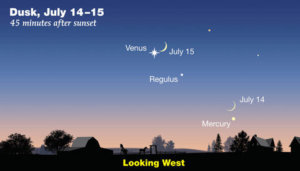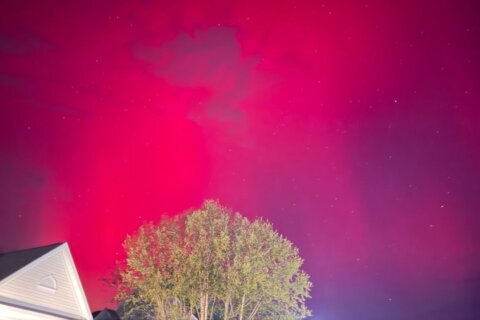Happy Friday the 13th, DMV! Don’t worry, it is safe to go out and see the celestial parade of the visible planets known to our ancestors — Mercury, Venus, Mars, Jupiter and Saturn — gracing our skies overnight.
Leading the way is Mercury and Venus in the west right after sunset; Venus is the brighter of the two. If you have an obstruction-free western horizon and a pair of binoculars, see if you can spot them 20-30 minutes after the sun sets. You will find Mercury low in the west to the lower right of Venus, not too far above the horizon.
After sunset, the thin crescent Moon will glide by Mercury on July 14 and then pair up with Venus for a stunning sky spectacle on July 15. Be sure to look for “Earthshine” on the Moon, a ghostly glow cast on the back half of our only natural satellite by sunlight bouncing off Earth’s oceans and clouds. It should be easily visible since the Moon reached perigee — its closest monthly point of approach to the Earth — on July 13.
Next up is mighty Jupiter in the southern sky. Jupiter is currently the fourth brightest object in the night sky — only the moon, Venus and mesmerizing Mars are brighter.
If you have binoculars, look at Jupiter and you should notice up to four small “stars” next to it. These are the four main moons of Jupiter discovered by Galileo in January 1610. You can download a free software program that will tell you which moons you are seeing. For binoculars, select “direct image” view.

(Courtesy Sky & Telescope)
To the left (east) of Jupiter is dimmer Saturn, which is increasingly visible as the sky grows darker. If you have a chance coming up, be sure to take a look at the ringed planet in a telescope. It will be a view you will never forget. Saturn is a yellowish-white color which stands out in the eastern boundary of the Milky Way — a glorious sight in dark countryside skies.
If you are viewing the sky from a dark area, the Milky Way is in its summer glory right now. Starting after 10 p.m., the Milky Way stretches across the sky from the northeast to the south and is quite the sight to see. Light pollution obscures the Milky Way from about 80 percent of humans in North America. In the relatively unpolluted skies of Shenandoah National Park, the vast interstellar dust clouds and star streams of our home galaxy are easily visible on a clear night. The Eastern Shore affords good viewing as well.
Saving the best for last, Mars (March is named after Mars) also rises at about 10 p.m. in the southeast. Mars is reddish-orange and will be getting brighter as the weeks pass by, as it will be at its closest to the Earth since 2003 on July 31. Mars is mesmerizing, as you see it in the sky fiery and bright in appearance. It is no wonder that the Romans named the planet the “God of War” — one could imagine that the planet is on fire.
Mars is still in the throes of a global dust storm that threatens the Mars rover Opportunity which is solar powered. Opportunity, also known as “Oppy,” is still in a low power sleep mode while it rides out a storm thick enough to completely rob the rover of the Sun’s energy. It is hoped Opportunity will survive. NASA’s nuclear-powered Curiosity, meanwhile, is fairing just fine and continues making observations of the storm.
Come up this summer to Shenandoah National Park for a variety of astronomy-related events, including some by yours truly. If you want to see dark skies, look through telescopes, and witness the Milky Way, Shenandoah is the place to be.
Save the date: Aug. 10-12, 2018 Shenandoah National Park will be hosting its third annual “Night Sky Festival.” There will be telescopes, Ranger-led astronomy activities and best of all, the Perseid Meteor Shower which will peak on the night between Aug. 12 and Aug. 13. Check the link for updates on the schedule. We’ll see you there!
Follow my daily blog to keep up with the latest news in astronomy and space exploration. You can email me at skyguyinva@gmail.com.







